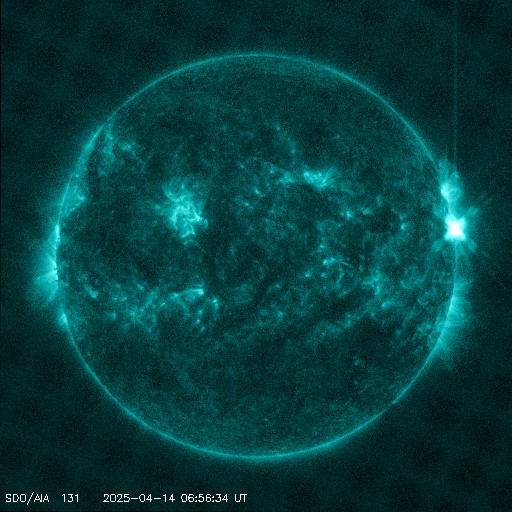Viewing archive of Sunday, 20 May 2012
Solar activity report
Any mentioned solar flare in this report has a scaling factor applied by the Space Weather Prediction Center (SWPC). Because of the SWPC scaling factor, solar flares are reported as 42% smaller than for the science quality data. The scaling factor has been removed from our archived solar flare data to reflect the true physical units.
Report of Solar-Geophysical Activity 2012 May 20 2200 UTCPrepared by the NOAA © SWPC and processed by SpaceWeatherLive.com
Joint USAF/NOAA Report of Solar and Geophysical Activity
SDF Number 141 Issued at 2200Z on 20 May 2012IA. Analysis of Solar Active Regions and Activity from 19-2100Z to 20-2100Z
Solar activity was at very low levels. New Region 1487
(N19W05) emerged on the disk as a simple bi-polar group. Region 1483
(S25W43) developed additional trailer spots and is now classified as
a D-type group. All other regions were quiet and stable. No
Earth-directed CMEs were observed during the period.
IB. Solar Activity Forecast
Solar activity is expected to be at
predominately low levels for the next three days (21 - 23 May). A
slight chance for M-class activity exists all three days.
IIA. Geophysical Activity Summary 19-2100Z to 20-2100Z
The geomagnetic field was at quiet to active levels with an isolated
minor storm interval during the 20/0300 - 0600Z period. At about
20/0136Z, the ACE satellite observed an interplanetary (IP) shock
passage with a corresponding weak sudden impulse observed at the
Boulder magnetometer (15 nT) at 20/0215Z. Prior to the IP shock,
solar wind velocities were generally in the 400 km/s range, the Bz
component of the interplanetary magnetic field (IMF) varied between
+/- 3 nT and the total field (Bt) was at 5 nT. Following the shock,
wind speeds increased to about 475 km/s, Bz varied between +/- 8 nT
and Bt increased to about 8 nT. The shock likely indicated the
arrival of the 17 May CME.
IIB. Geophysical Activity Forecast
The geomagnetic field is
expected to be at predominately quiet levels for day one (21 May).
By days two and three (22 - 23 May), quiet to unsettled levels with
a slight chance for isolated active periods are expected due to
coronal hole high speed stream effects coupled with the arrival of
the 18 May CME.
III. Event Probabilities 21 May to 23 May
| Class M | 15% | 15% | 15% |
| Class X | 05% | 05% | 05% |
| Proton | 01% | 01% | 01% |
| PCAF | green | ||
IV. Penticton 10.7 cm Flux
Observed 20 May 131 Predicted 21 May-23 May 130/130/135 90 Day Mean 20 May 116
V. Geomagnetic A Indices
Observed Afr/Ap 19 May 005/005 Estimated Afr/Ap 20 May 010/012 Predicted Afr/Ap 21 May-23 May 007/006-010/010-007/010
VI. Geomagnetic Activity Probabilities 21 May to 23 May
| A. Middle Latitudes | |||
|---|---|---|---|
| Active | 10% | 20% | 20% |
| Minor storm | 01% | 10% | 10% |
| Major-severe storm | 01% | 01% | 01% |
| B. High Latitudes | |||
|---|---|---|---|
| Active | 10% | 25% | 25% |
| Minor storm | 01% | 15% | 15% |
| Major-severe storm | 01% | 01% | 01% |
All times in UTC
Current data suggests there is a slight possibility for aurora to appear at the following high latitude regions in the near future
TórshavnOulu
Reykjavik
Luleå
Latest news
Latest forum messages
AR 4055 992025/04/12-13 Filament CMEs 2025/04/16 G2 Watch 38Incoming & Unnumbered Active Regions 1700Unspecified geomagnetic activity 2258Potential AR4062 8
More topicsSupport SpaceWeatherLive.com!
A lot of people come to SpaceWeatherLive to follow the Sun's activity or if there is aurora to be seen, but with more traffic comes higher server costs. Consider a donation if you enjoy SpaceWeatherLive so we can keep the website online!

Latest alerts
Monday, 14 April 2025
23:15 UTC - Geomagnetic activity
Active geomagnetic conditions (Kp4) Threshold Reached: 23:01 UTC
07:09 UTC - Solar flare
Moderate M4.28 flare from sunspot region 4055
06:48 UTC - Radio Blackout
Minor R1 radio blackout in progress (≥M1 - current: M1.53)
06:24 UTC - Solar flare
Moderate M1.49 flare from sunspot region 4055
06:06 UTC - Radio Blackout
Minor R1 radio blackout in progress (≥M1 - current: M1.16)
Space weather facts
| Last X-flare | 2025/03/28 | X1.1 |
| Last M-flare | 2025/04/14 | M4.2 |
| Last geomagnetic storm | 2025/04/06 | Kp5 (G1) |
| Spotless days | |
|---|---|
| Last spotless day | 2022/06/08 |
| Monthly mean Sunspot Number | |
|---|---|
| March 2025 | 134.2 -20.4 |
| April 2025 | 132.1 -2.1 |
| Last 30 days | 130.6 -13.6 |





